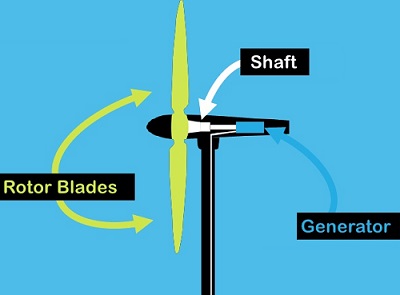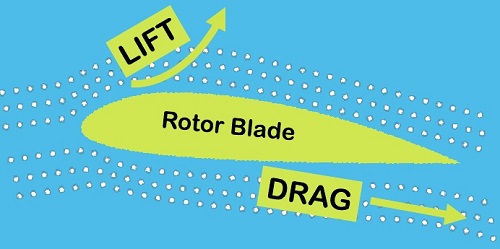What is Windmill or Wind Power Turbine?
Windmill or wind turbines are very simple devices which are used to generate wind electricity by using the wind power. The principle of wind mill is very simple i.e. convert the wind’s kinetic energy into mechanical energy which further converts the mechanical energy to electricity so the overall system can be called as wind electricity generator. Wind energy is the cleanest form of source for generating renewable energy.
Wind energy blows the blade of the turbine or the wind turbine converting the kinetic energy in the wind to mechanical energy while the attached generator converts the mechanical energy to electrical energy.
Construction of Wind Turbine
There are different types and shapes of wind turbines which are used mainly for converting the wind power in to wind energy i.e. electricity. Basically all wind turbine systems are composed of below components:

wind-mill-turbine-construction
- Rotor Blades are used to catch the wind power so these are wind catchers. Rotor blades are having long projections which are aerodynamically designed for maximum performance. Whenever wind passes through them it forces the blades to rotate or turn.
- Shaft is a simple rod that is connecting the blades to generator. Main purpose of the connecting rod is is to transfer the rotational mechanical energy of the rotor blades to the generator.
- Generator is a device designed to convert mechanical energy into electrical energy by applying the principle of electromagnetic induction.
Operating Principle of Wind Turbine
Wind energy is captured using the wind turbine’s rotor blades, whenever wind passes through the blades, two aerodynamic forces are at work i.e. lift and drag. These two forces cause the rotor blades to turn, the speed of turn and force applied depends on how much force the wind exerts on them i.e wind speed and direction. The process converts the wind’s kinetic energy to mechanical energy causing the turning of rotor blades. Whenever the rotor blade turns it also causes the shaft to turn resulting the generation of electricity.

In most cases you might have observed that large wind turbines turn very slowly which is on average 20 rpm or rotations per minute which is not sufficient to power up a generator. Therefore large wind turbines use a gearbox to increase the rpm from 20 rpm to as much as 2000 rpm hence getting the desired rotational speed for shaft to generate wind electricity.
Calculation of Wind Power Efficiency
Efficiency of a wind turbine or windmill depends upon five factors i.e. wind power, altitudes, Obstructions, Blade aerodynamics & Air temperatures.
Wind power is calculated depending upon the formula.
P = k V F
where:
P = Wind Power
V = Wind Velocity
F = Wind Force
k = Constant
Types of Wind Turbines
Generally there are two types of wind turbines i.e. Horizontal Axis Turbines and Vertical Axis Turbines.
Advantages of Horizontal axis turbine or windmill
- Variable blade pitch, which gives the turbine blades the optimum angle of attack
- The tall tower base allows access to stronger wind in sites with wind shear.
- High efficiency, since the blades always move perpendicularly to the wind, receiving power through the whole rotation.
Disadvantages of Horizontal Axis Wind Turbines
- Tall towers and blades up to 90 meters long are difficult to transport. Transportation can now cost 20% of equipment costs.
- Tall HAWTs are difficult to install, needing very tall and expensive cranes and skilled operators
- Massive tower construction is required to support the heavy blades, gearbox, and generator
Advantages of Vertical Axis Wind Turbines
- Accepts wind from any angle
- Components can be mounted at ground level
- Ease of service
- Lighter weight towers
- Can theoretically use less materials to capture the same amount of wind
Disadvantages of Vertical Axis Wind Turbine
- Rotors generally near ground where wind poorer
- Centrifugal force stresses blades
- Poor self-starting capabilities
- Requires support at top of turbine rotor
- Requires entire rotor to be removed to replace bearings
- Overall poor performance and reliability
- Have never been commercially successful
Discover more from Electrical Engineering 123
Subscribe to get the latest posts to your email.

